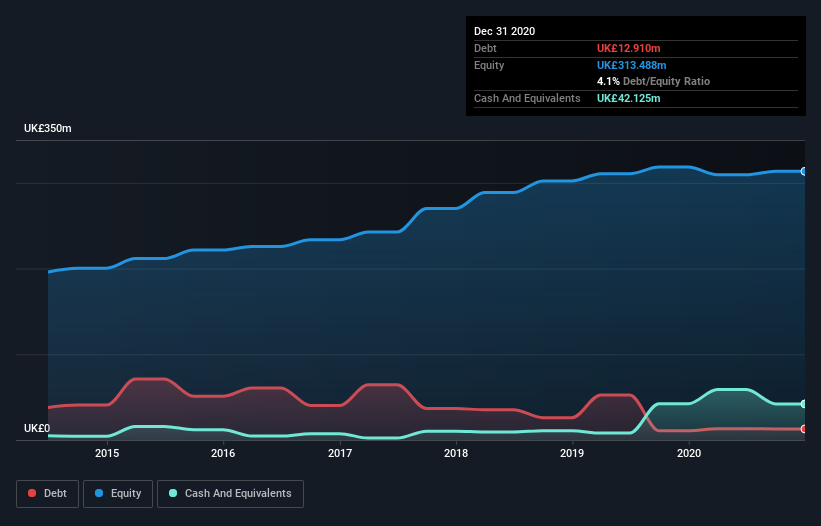We Think Henry Boot (LON:BOOT) Can Stay On Top Of Its Debt
Legendary fund manager Li Lu (who Charlie Munger backed) once said, 'The biggest investment risk is not the volatility of prices, but whether you will suffer a permanent loss of capital.' It's only natural to consider a company's balance sheet when you examine how risky it is, since debt is often involved when a business collapses. As with many other companies Henry Boot PLC (LON:BOOT) makes use of debt. But is this debt a concern to shareholders?
What Risk Does Debt Bring?
Generally speaking, debt only becomes a real problem when a company can't easily pay it off, either by raising capital or with its own cash flow. In the worst case scenario, a company can go bankrupt if it cannot pay its creditors. However, a more common (but still painful) scenario is that it has to raise new equity capital at a low price, thus permanently diluting shareholders. Having said that, the most common situation is where a company manages its debt reasonably well - and to its own advantage. The first thing to do when considering how much debt a business uses is to look at its cash and debt together.
Check out our latest analysis for Henry Boot
How Much Debt Does Henry Boot Carry?
You can click the graphic below for the historical numbers, but it shows that as of December 2020 Henry Boot had UK£12.9m of debt, an increase on UK£10.7m, over one year. However, it does have UK£42.1m in cash offsetting this, leading to net cash of UK£29.2m.
How Healthy Is Henry Boot's Balance Sheet?
According to the last reported balance sheet, Henry Boot had liabilities of UK£89.7m due within 12 months, and liabilities of UK£51.4m due beyond 12 months. Offsetting this, it had UK£42.1m in cash and UK£78.4m in receivables that were due within 12 months. So it has liabilities totalling UK£20.6m more than its cash and near-term receivables, combined.
Since publicly traded Henry Boot shares are worth a total of UK£375.7m, it seems unlikely that this level of liabilities would be a major threat. Having said that, it's clear that we should continue to monitor its balance sheet, lest it change for the worse. While it does have liabilities worth noting, Henry Boot also has more cash than debt, so we're pretty confident it can manage its debt safely.
The modesty of its debt load may become crucial for Henry Boot if management cannot prevent a repeat of the 82% cut to EBIT over the last year. When a company sees its earnings tank, it can sometimes find its relationships with its lenders turn sour. The balance sheet is clearly the area to focus on when you are analysing debt. But it is future earnings, more than anything, that will determine Henry Boot's ability to maintain a healthy balance sheet going forward. So if you want to see what the professionals think, you might find this free report on analyst profit forecasts to be interesting.
Finally, a company can only pay off debt with cold hard cash, not accounting profits. While Henry Boot has net cash on its balance sheet, it's still worth taking a look at its ability to convert earnings before interest and tax (EBIT) to free cash flow, to help us understand how quickly it is building (or eroding) that cash balance. In the last three years, Henry Boot's free cash flow amounted to 30% of its EBIT, less than we'd expect. That weak cash conversion makes it more difficult to handle indebtedness.
Summing up
We could understand if investors are concerned about Henry Boot's liabilities, but we can be reassured by the fact it has has net cash of UK£29.2m. So we are not troubled with Henry Boot's debt use. There's no doubt that we learn most about debt from the balance sheet. However, not all investment risk resides within the balance sheet - far from it. For instance, we've identified 3 warning signs for Henry Boot that you should be aware of.
When all is said and done, sometimes its easier to focus on companies that don't even need debt. Readers can access a list of growth stocks with zero net debt 100% free, right now.
This article by Simply Wall St is general in nature. It does not constitute a recommendation to buy or sell any stock, and does not take account of your objectives, or your financial situation. We aim to bring you long-term focused analysis driven by fundamental data. Note that our analysis may not factor in the latest price-sensitive company announcements or qualitative material. Simply Wall St has no position in any stocks mentioned.
Have feedback on this article? Concerned about the content? Get in touch with us directly. Alternatively, email editorial-team (at) simplywallst.com.

